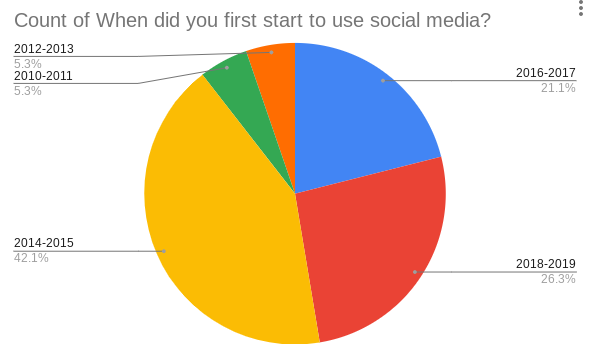Braylon Dunlap
Staff Writer

For the past twenty years, social media has seemingly had a bigger impact on teenagers more than any other demographic. Apps like TikTok, Instagram, and Snapchat have played major parts in many of our lives.
But just how big a role?
Recently, a series of surveys were sent out to the SLA student body by the current statistics students. One of these surveys focused on social media apps and their impact.
History of Use
From the data, 48% of the participants stated that they started using social media between the years of 2016 to 2019. That makes seniors anywhere from eleven to fourteen years old when they started. The next largest group — 42% of the participants — started using social media anywhere from 2014 to 2015. That means most seniors started using social media when they were eight years old but that age would be even younger if any of the participants are a junior or lower.

After interviewing a handful of students, all of them responded “No” when asked if the age they started using social media was an appropriate age but had varying answers on whether it negatively affected their mental health.
“I got social media to keep in contact with my friends during quarantine and it wrecked my life,” said Sophomores Julian Sankey. “Everyone looked like they were having a good time, especially during quarantine.”
“My parents let me have a phone at the age of twelve and I only got Instagram which was the first social media I got at the age of fourteen,” said 10th Grader Miles Hall “I kind of wish I had waited longer, or probably haven’t gotten it at all, but I have it now and I’d say it hurts my mental health.”
No one said they wished they started earlier.
All of the respondents also said that Instagram was their first or only social media platform. Instagram being an image/video sharing app, is known for creating high expectations and standards in many young adults’ mentalities.
And while many of the students said starting early had a negative effect on their mental health, Junior Elijah Lopez said he had guidance early on.
“My parents always taught me the dangers of social media, and I mostly just used it to talk to friends so it wasn’t draining for me mentally, but I wouldn’t recommend using social media that early.”
Mental Impact
Respondents were also asked how often they compare themselves to others online and how much social media impacts their view of themselves/others on a 1-10 scale. An estimated 40% chose 8, and when asked how often they compare themselves to others on social media, 36% said a few times per week, while another 36% said that they do it a few times a month. On top of that, 10% of participants responded that they compare themselves to others online daily.
Students in the class had personal responses to the survey results.
Statistics Student Senior Mehki Evans-El said “I actually deleted a lot of my social media apps after this because now after acknowledging and seeing it, I realized that I do actually have a problem.”
One thing that can be noted about social media is that often, people don’t realize that they are addicted to social media and that it might start being an issue.
This survey may encourage students to reflect on how much they use social which is important in determining whether they have an addiction or not.
The results of this survey do shed more light onto the fact that social media can definitely be harmful to young adults at times, and it can make kids develop addictions to these apps or alter the way they see themselves and others negatively.
“We know phones are an important part of our lives and we wanted to see how it specifically affects our students. I actually deleted a lot of my social media apps after this because now after acknowledging and seeing it, I realized that I do actually have a problem.” Mehkki said. “It was affecting my work in school and I would constantly go on my phone. After reading the data I became more self-aware.”
“Overall, I think that the biggest takeaway was that conducting proper, scientific surveys is a huge job,” Mr. Estey said of the project.
“It’s very easy to put up a quick poll on your Instagram page, but if you want a survey that accurately represents a large and diverse population – even a population like SLA’s 500 high school students – you need to put in a tremendous amount of thought and planning behind the scenes!”
Leave a Reply